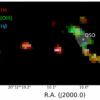A team of scientists from Argentina and Spain have reported the first observational evidence that a type of young low-mass star, known as “T Tauri stars,” are capable of emitting gamma radiation. The study is published in Monthly Notices of the Royal Astronomical Society.
Very energetic radiation from the sky cannot be easily observed from Earth. The high sensitivity of the Fermi satellite helps to solve this issue by observing the universe in gamma-rays, the most energetic region of the electromagnetic spectrum.
The Fermi satellite has been continuously observing the sky since its launch in 2008, and from these observations it is known that about 30% of gamma-ray sources detected throughout the entire night sky remain unidentified—the origins of these gamma-ray detections are unknown.
Some of these mysterious sources were studied by Ph.D. student Agostina Filócomo and a team of researchers in order to determine their origin. Several of the gamma-ray sources appear to originate from star forming regions, but the team had no explanation as to why—so they decided to investigate. The study focuses on star-forming region NGC 2071, which lies in the northern part of the molecular cloud Orion B.
To try and pinpoint the cause of these mysterious gamma-ray bursts, the team decided to look to objects known as “T Tauri stars,” which are low-mass stars in formation. T Tauri stars consist of a central star and a disk of gas and dust orbiting around it, where planets could form. T Tauri stars are known for their fluctuating brightness, and are typically found near regions of active star formation.
The team noted that three unidentified gamma sources observed at different time intervals were coming from the part of the sky that the young star-forming region NGC 2071 is located. At least 58 stars classified as T Tauri stars are known to be forming here. There are no other objects in this region that can be a source of gamma-ray emission.
A possible explanation is that sporadic gamma-ray radiation is produced by T Tauri stars during powerful flare episodes known as “megaflares,” in which electromagnetic bursts are produced by magnetic energy stored in the atmospheres of the stars.
Megaflares can span several stellar radii and last a few hours. Although there is flare activity on the sun at present, it is not on the same scale as a megaflare. Megaflares are far more powerful, and if they were to take place on the sun, would be detrimental to life on planet Earth.
This might explain the origin of multiple previously unknown gamma-ray sources. Understanding the physical processes in T Tauri stars also provides information on the early conditions that led to the genesis of the sun and our solar system.
Ph.D. student Agostina Filócomo claims, “This observational evidence is essential for understanding the origin of sources that have previously remained unknown for more than a decade, which is unquestionably a step forward in astronomy.”
“It is also critical to comprehend the processes that occur during the early phases of star formation: if a T Tauri star produces gamma-ray radiation, it will affect the gas conditions of the protoplanetary disk and, consequently, the evolution of planet formation. The discovery of this phenomenon serves to understand how not only the sun but also our home planet, Earth, were formed and evolved.”
More information:
A Filócomo et al, γ-ray detection from occasional flares in T Tauri stars of NGC 2071—I. Observational connection, Monthly Notices of the Royal Astronomical Society (2023). DOI: 10.1093/mnras/stad2029
Provided by
Royal Astronomical Society
Citation:
First observational evidence of gamma-ray emission in young sun-like stars (2023, August 23)



